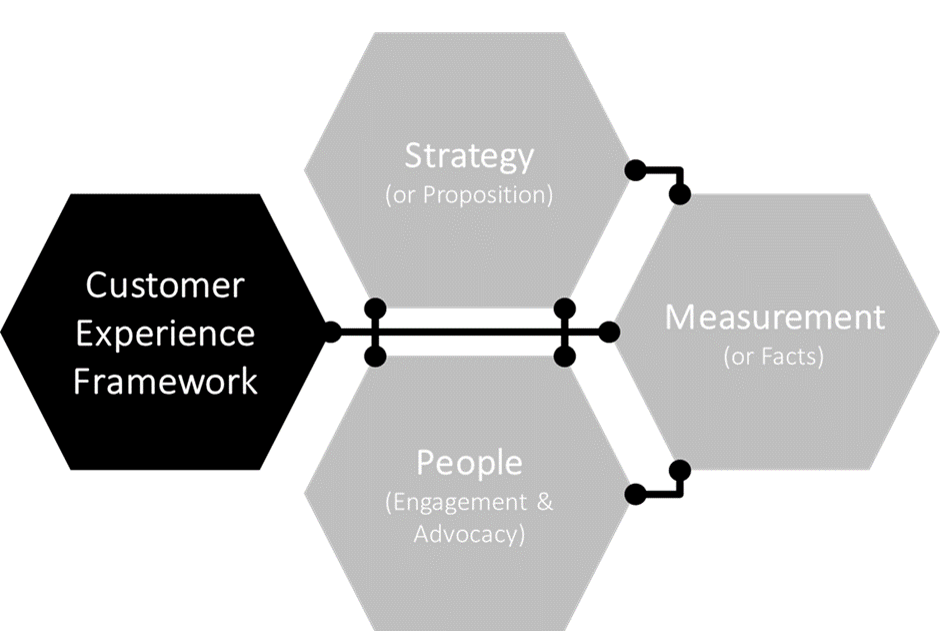
As customer experience has become increasingly recognised as a thing of tangibility, so has the need to adopt and embed the skills and competencies that make managing it (customer experience that is) a reality. Any ‘concept’ that becomes something requiring methodologies, approaches, tools and techniques, also requires the need for people to understand how to use, deploy and embed them. Fortunately, the profession that customer experience has become is steadily building a burgeoning number of just such people.
What all seasoned customer experience professionals know, is that you can have all the tools and methodologies in the world, but if the culture of an organisation does not support your ability to transform the way that organisation behaves, then customer centric transformation may remain a pipe dream. Culture change underpins all other aspects of customer experience transformation – in this article, I am delighted to share with you my top 7 tips to achieve it based on my experiences both on the inside and outside of organisations in a multitude of industries all over the world. Let’s start with my tip number 1:
Tip 1 – Make customer experience a priority for the whole company!

Now it may sound obvious, but if an organisation aspires to have a customer centric culture, then it MUST make customer experience a priority for everyone. It is not exclusively the domain of the customer experience team; or marketing; or customer service. It is not a project or an initiative.
To transform the culture of a business to one that is focused on enabling everyone to THINK and ACT in the interests of the customer, then everyone must be clear about the tole they play in making that a reality. In practice, linking performance objectives and remuneration of every single employee to a continuous improvement of customer experience is the most effective way to achieve this.
Tip 2 – Embed a customer experience framework

I have written recently about what I describe as the ‘Customer Experience Jigsaw Puzzle’. To create a customer centric culture, it is critical that a business is able to introduce and embed some rigor and structure into the way it goes about managing the customer experience. The deployment of a customer experience management framework not only enables an organisation to focus on connecting multiple activities, it also creates an environment that engenders a sustainable approach to continuous improvement of the customer experience.
Many frameworks have been created around the world – this is the generic one that I use to teach organisations about the principle.

A number of organisations have chosen to deploy a ‘maturity model’ approach to embedding rigor to the way the customer experience is managed; I am also a big advocate of that concept. Whatever you choose to use, I believe that the structure a framework or maturity model will afford an organisation, the more likely it is that the underpinning culture will be able to transform into one that is sustainably customer centric.
Tip 3 – Experience your customer and employee journeys

If a business wants to transform its culture, then it is vitally important that its people at all levels understand how it FEELS to be a customer and to be an employee. The over used phrase of ‘walking in the customers’ shoes’ is one that must not just be said – it must be one that is genuinely and authentically applied.
To embed a customer centric culture, all leaders would regularly be meeting and speaking to customers. They would regularly be experiencing what the customer experiences to enable them to understand what works and what doesn’t work. Their understanding of what it feels like to be a customer will give them an inherently better ability to make customer focused decisions.
Yet it is just as important for leaders to understand how it feels to be an employee – to work on the front line to get a sense of how easy (or not) it is to be able to deliver the customer journey. It is also just as important for employees at all levels to have an appreciation of each other – to know what everyone does to deliver the end to end customer journey.
Tip 4 – Engage your people in improvement activity

To move step three one stage further, if you want to embed a customer centric culture, then engaging your people in improving the customer experience is a fantastic way to make it happen. Too many organisations try and ‘DO’ things to their people. When it comes to influencing your people to change the way they behave, make them part of the change that needs to be made, rather than just doing it to them.
If you ask your people to help you improve the customer experience, they are only too willing. Too often an organisations employees are the ‘missing voice’ when it comes to customer strategy. Yet a customer centric organisation is one that recognises the critical role its people plays in being able to understand where and how to improve the customer journey. Encouraging them to suggest ways to not just correct issues that occur, but to find ways of preventing them from happening again is remarkably empowering and a sure fire way of continuing to transform organisational culture.
Tip 5 – Ensure customer experience is a key element of the business strategy

An organisation with a customer centric culture is one that recognises it does not just exist to make money. Whilst this may seem like a rather strange statement, in reality, too many businesses have actually lost sight of the fact that they do not exist to make money – they do so to fulfil a purpose. The better able an organisation is to fulfil its purpose, the more money it will make.
This is a subtle but very significant difference. If a business subconsciously believes it exists solely to make money, it will only focus on the things important to it (the business) in developing and deploying its strategy. If that is the case, what the customer wants and needs from the organisation will be subconsciously absent from the strategy. To be a truly customer centric business, it is vital that customer experience is a key element of the business strategy.
Strategy needs to be a balance between what the business wants and what the customer wants. Creating that balance would mean that the strategy does not just focus on business driven metrics (revenue, profit, cost etc..), but also customer driven ones (loyalty, satisfaction, effort etc…). The better able a business is to create that balance, the more likely it is that it will not just deliver a better customer experience – it will also deliver a better employee experience.
Tip 6 – Communicate, communicate, communicate!

When it comes to creating a customer centric culture, you cannot over communicate the importance of the customer experience and work being done across the organisation around it. A customer centric business talks about customer experience regularly – not just once a month or once a year – but all the time. Through intranets; corporate magazines; leadership presentations; physical events; badges and leaflets; no employee can avoid the fact that the customer is at the heart of everything the business does.
If you want to be sustainably customer centric, you must tell everyone that is the case – and then tell them again – and again – and again. Communication is such a vital component – the more creative and inventive you are in getting the message across, the better!
Tip 7 – Get recognition and build authority

To sustain a focus on the customer experience and the desire to be a business that is customer centric in the way it behaves, getting recognition for the way you do it and for what has been achieved is incredibly effective.
I am a huge advocate of winning external awards for the work does is done around customer experience – in my experience, where external recognition has been gained in this way, it has been hugely significant in motivating people at all levels of the organisation to stay focused on driving the customer centric agenda.
Winning awards gives an organisation ‘authority’ in customer experience – it allows people to recognise the great things that are being done and drives them to want to do even more. Yet recognition of the importance of customer experience also comes in the form of knowledge. Your ability to transfer knowledge to your people will also build their personal authority in the subject. That authority will have an effect of driving them to focus on the customer indefinitely – it is that that sustains a customer centric culture.
So there you have it – my top tips to create a customer centric culture. It is very likely that you have more to add – I would encourage you to comment on this article and share your thoughts so that others can benefit from as wide a perspective from the customer experience community as possible.
One thing I can say confidently, is that the tips in this article work – I have seen them deployed in real life – they are not just theory. Yet creating a sustainable customer centric culture is not easy – if you work in a business that is not there yet – get them to read this!




What’s probably most important for organizations looking to become customer-obsessed, as well as customer-centric, is that, in addition to cultural DNA and customer-focused processes, employees are the engine that make this work. Glad to see this factor receive appropriate attention here.
Hi Ian: While I agree with these points overall, they are heavy on management, which, when it comes to differentiated customer experience, gets stultifying, to say the least. Can frameworks turn anybody on?
I have observed that companies which excel at customer centricity have people on board who are really, really jazzed about the company’s industry and its products or services. Something that’s clear if you’ve purchased, for example, outdoor recreation equipment. To me, it seems hard to “manage” passion and enthusiasm into customer-facing employees. If you’re simply not excited about processing mortgage loan applications, I question whether your steps will create a star performer. Best to get people aboard who love consumer finance, snowboarding, biking, woodworking, gardening, what-have-you, in the first place.
I particularly like your third point, and it amazes me that when I’ve asked helpline staff whether they’ve tried calling their own support number, I have yet to receive an answer in the affirmative. That’s a huge lost opportunity. For a scant investment of 20 minutes or so per employee per week, service personnel would have a much clearer idea of what a customer has experienced by the time a call gets to the right representative.
Like Andrew I agree with the overall approach, but believe it can be too managed. We all know that far too many CX ‘transformations’ fail. In my experience, that’s because 2 primary things happen: it’s too ‘managed’ , and on the flip side, creates too many incremental improvement activities that are uneccessary, or diverge from, or collide with, others as you look across an organisation. I think companies should not have CX as a strategy per se, but have a clear picture of the CX they and their brand wants to stand for. Most companies will be unable to transform themselves like an Amazon. Incremental improvements are chasing the tail of the CX – everyone’s doing it, of course, and all that’s happening is a raising of the bar but still no standout differentiation. Organisations should have a strategy of 2,3 or 4 exceptionally different approaches that standout in their marketplace. Not every part of every journey needs to be excellent – that’s what makes the standout parts seem so differentiated.